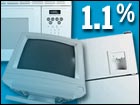
NEW YORK (CNN/Money) -
Demand for long-lasting durable goods jumped last month in the United States, the government said Thursday, a sign that business spending -- often cited as key to the broader economy's recovery -- may finally be making a comeback.
"An economy in neutral has started to move forward," Wachovia Securities economist John Silvia said in a report Thursday.
And while the labor market remains weak, according to the latest jobless claims figures, higher business spending could pave the way for increased production and, eventually, hiring.
The Commerce Department reported that orders for goods made to last three years or longer, such as cars and computers, jumped 1.1 percent in April to $176.6 billion after a revised 0.2 percent gain in March. Economists surveyed by Briefing.com expected durable-goods orders to rise 0.5 percent.
"This report provides the first indication of the state of capital spending in the second quarter, and the data were quite strong," Merrill Lynch chief economist Bruce Steinberg wrote in a report.

But durable goods orders are notoriously volatile -- March's gain was previously reported as a 0.6 percent decline. Business spending, which accounts for about 13 percent of gross domestic product -- the broadest measure of the nation's economy -- fell nearly 11 percent in the first quarter from a year earlier.
"When it's as low as it was, it takes time to start turning it around. Today's report doesn't mean there's a boom, but it certainly is encouraging," said Delos Smith, economist at the Conference Board, a business research firm that tracks consumer confidence and other economic trends.
Separately, the number of Americans filing new claims for unemployment benefits fell to 416,000 last week from an upwardly revised 425,000 the prior week, the Labor Department reported. It was the seventh straight week that claims were above 400,000, a level pointing to a sluggish job market. Economists surveyed by Briefing.com expected 410,000 new claims.
On Wall Street, stock prices fell despite the encouraging news, while Treasury bond prices rose.
| |
 Related stories
Related stories
| |
| | |
| | |
|
The surge in durable goods orders should be somewhat heartening to businesses, since it implies that consumers and other businesses are continuing to spend money, ignoring the weak labor market and spotty recovery in the broader economy.
Though orders for aircraft plunged 37 percent -- giving back some of February's 60 percent gain -- orders for motor vehicles and parts jumped 12 percent, the biggest gain since August 1998. Orders for computers and electronic equipment rose 2.5 percent after gaining 0.5 percent in March. Orders for machinery rose 4 percent after falling 1.5 percent in March.
Excluding transportation -- and the big drop in demand for aircraft -- goods orders jumped 2.9 percent. Excluding defense orders, they rose 3.4 percent. And orders for non-defense capital goods -- equipment for use by private farms and businesses -- rose 1.9 percent after falling 3.1 percent in March.
Meanwhile, inventories fell for the 16th straight month as manufacturers again shed unsold stockpiles of goods that built up when business spending ground to an abrupt halt last year.
"It's pretty clear that all the pieces for capital spending are in place, including rising sales, lower inventories and increases in shipments and orders," said Sung Won Sohn, chief economist at Wells Fargo & Co. "So, despite what CEOs say in public, there's no question that capital spending -- outside of aircraft and telecommunications -- has bottomed and is on the way up."
Labor market weakness continues
Federal Reserve Chairman Alan Greenspan and other economists have called business spending the key to the economy's recovery from a recession that began in March 2001. A prolonged slump in business spending paved the way for the broader economic downturn, after all.
"One or two more months like this [durable goods] report, and even the Fed Chairman will have to start to admit that things look good," said Joel Naroff, chief economist and president of Naroff Economic Advisors in Holland, Pa.
Businesses are operating more efficiently, thanks to strong productivity gains that could also fuel higher profits this year, which is often a precursor to higher spending, according to a recent study by Banc One Economic Advisors economist Anthony Chan.
But that efficiency also means businesses will be reluctant to hire new workers until they're certain demand will be high enough to justify more production. And continuing weakness in the labor market could eventually sap strength from consumer spending, which fuels two-thirds of the U.S. economy.
| |
 Related links
Related links
| |
| | |
| | |
|
Yet it's still unclear exactly how weak the labor market is, at least from the weekly claims numbers. The report, for example, does not indicate how many of last week's new claims came from workers refiling for unemployment insurance after Congress extended jobless benefits in March. The Labor Department has been unable to clearly separate new filers from refilers.
The four-week moving average of new jobless claims, which smoothes out fluctuations in the weekly data, fell to 420,000 last week from a revised 422,750 the prior week. But continued claims, the number of people who have been out of work for a week or more, rose to 3.87 million in the week ended March 11, the latest data available, from a revised 3.84 million the prior week.
"Overall, the labor market is improving, but progress is still slow," said Ian Shepherdson, chief U.S. economist at High Frequency Economics Ltd.
The Labor Department said earlier this month that the unemployment rate rose to 6 percent in April, its highest level in nearly 8 years. And many economists think the Fed is unlikely to raise its target for short-term interest rates -- already at 40-year lows in an effort to make borrowing cheaper and keep consumers spending -- until unemployment stabilizes.

|

